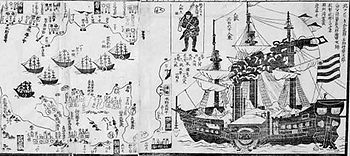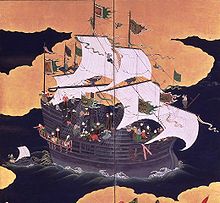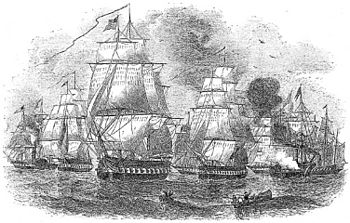- Black Ships
-
For the 2008 novel of this title, see Jo Graham.Not to be confused with The Black Ships (band) or Kurofune (EP).
The Black Ships (in Japanese, 黒船, kurofune, Edo Period term) was the name given to Western vessels arriving in Japan in the 16th and 19th centuries.
In 1543 Portuguese initiated the first contacts, establishing a trade route linking Goa to Nagasaki. The large carracks engaged in this trade had the hull painted black with pitch, and the term came to represent all western vessels. In 1639, after suppressing a rebellion blamed on the Christian influence, the ruling Tokugawa shogunate retreated into an isolationist policy, the Sakoku. During this “locked state,” contact with Japan by Westerners was restricted to Dejima island at Nagasaki.
In 1844, William II of the Netherlands urged Japan to open, but was rejected. On July 8, 1853, the U.S. Navy with four warships steamed into the bay at Edo, requesting that Japan open to trade with the West. Their arrival marked the reopening of the country after more than two hundred years of self-imposed isolation.
In particular, Kurofune refers to Mississippi, Plymouth, Saratoga, and Susquehanna, that arrived on July 14, 1853 at Uraga Harbor (part of present-day Yokosuka) in Kanagawa Prefecture, Japan under the command of United States Commodore Matthew Perry.[1] Black refers to the black color of the older sailing vessels, and the black smoke from the coal-fired power plants of the American ships. In this sense, the Kurofune became a symbol of the ending of isolation.
Contents
First kurofune ships: nau do trato
In 1543 Portuguese traders arrived in Japan initiating the first contacts with the West. Soon they established a trade route linking their headquarters in Goa, via Malacca to Nagasaki. Large carracks engaged in the flourishing "Nanban trade", introducing modern firearms to Japan, arquebuses, a major innovation of the Sengoku period a time of intense internal warfare, and also refined sugar, optics and other inventions. Later, they engaged in triangular trade, exchanging silver from Japan with silk from China via Macau.[2]
Large carracks of 1200 to 1600 tons[3] - named nau do trato, silver naus, and China's naus by the Portuguese[4] - engaged in this trade had the hull painted black with pitch, and the term[5] came to name all western vessels. The name was inscribed in the Nippo Jisho, the first western Japanese dictionary compiled in 1603.
In 1549 missionary Francis Xavier started a Jesuit mission in Japan. Christianity spread, mingled with the new trade, making some 300,000 converts among peasants and some daimyō (warlords). In 1637 the Shimabara Rebellion blamed on the Christian influence was suppressed. Portuguese traders and Jesuit missionaries faced progressively tighter restrictions, and were confined to the island of Dejima before being expelled in 1639.
The Tokugawa shogunate retreated back into a policy of isolationism, the Sakoku (鎖国?, "locked country") forbidding contact with most outside countries. Only a limited-scale trade and diplomatic relations with China, Korea, the Ryukyu Islands and the Netherlands was maintained.[6] The Sakoku policy remained in effect until 1853 with the arrival of Commodore Matthew Perry and the opening of Japan.
Gunboat diplomacy
Commodore Perry's superior military force was a factor in negotiating a treaty allowing American trade with Japan, thus effectively ending the Sakoku (鎖国) period of more than 200 years in which trading with Japan had been permitted to the Dutch and Chinese exclusively.
The following year, at the Convention of Kanagawa, Perry returned with eight ships and was presented by the shogun's officials with the "Treaty of Peace and Amity", establishing formal diplomatic relations between Japan and the United States. Within five years, Japan had signed similar treaties with other western countries. The Harris Treaty was signed with the United States on July 29, 1858.
The surprise and confusion these ships inspired are described in this famous kyoka (a humorous poem similar to the 5-line waka):
泰平の Taihei no 眠りを覚ます Nemuri o samasu 上喜撰 Jōkisen たった四杯で Tatta shihai de 夜も眠れず Yoru mo nemurezu This poem is a complex set of puns (in Japanese, kakekotoba or "pivot words"). Taihei (泰平) means "tranquil"; Jōkisen (上喜撰) is the name of a costly brand of green tea containing large amounts of caffeine; and shihai (四杯) means "four cups", so a literal translation of the poem is:
- Awoken from sleep
- of a peaceful quiet world
- by Jokisen tea;
- with only four cups of it
- one can't sleep even at night.
However, there is an alternate translation, based on the pivot words. Taihei can refer to the "Pacific Ocean" (太平); jōkisen also means "steam-powered ships" (蒸気船); and shihai also means "four vessels". The poem, therefore, has a hidden meaning:
- The steam-powered ships
- break the halcyon slumber
- of the Pacific;
- a mere four boats are enough
- to make us lose sleep at night.
'Black Ships' (Kurofune) is also the title of the first Japanese Opera, composed by Kosaku Yamada, "based on the story of Tojin Okichi, a geisha caught up in the turmoil that swept Japan in the waning years of the Tokugawa shogunate" [7] and premiered in 1940.[8]
See Also
A TV miniseries starring Richard Chamberlain entitled Shōgun (1980) - It was based on a book by James Clavell (1975) of the same name which described the fictional experiences of an Englishman shipwrecked in Japan during the 17th century, near the end of Japan's first experience with foreigners.
Another film concerning Perry's arrival in Japan was The Bushido Blade (1981) starring actor Richard Boone as Admiral Perry.
See also
- Treaty of Shimoda
- French Military Mission to Japan (1867-1868)
- Gunboat diplomacy
- Dutch missions to Edo
- Manifest destiny
- Sakoku
- Unequal Treaties
- United States Korean Expedition of 1871
- Pacific Overtures
- Madama Butterfly, a representation of the roughly the same times in a European perspective
Notes
- ^ "Perry Ceremony Today; Japanese and U. S. Officials to Mark 100th Anniversary". New York Times. July 8, 1953. http://select.nytimes.com/mem/archive/pdf?res=F00A16FD3C59177B93C6A8178CD85F478585F9.
- ^ Boxer, C.R. (1951). The Christian Century in Japan. USA: University of California Press. pp. 91–137. ISBN 9781857540352. http://books.google.com/books?id=2R4DA2lip9gC&lpg=PA91&dq=kurofune%20portuguese&pg=PA91#v=onepage&q=kurofune%20portuguese&f=false.
- ^ Subrahmanyam, Sanjay (1993). The Portuguese empire in Asia, 1500-1700: a political and economic history. University of Michigan: Longman. pp. 138. ISBN 0582050693.
- ^ Rodrigues, Helena. "Nau do trato". Cham. Cham. http://www.fcsh.unl.pt/cham/eve/content.php?printconceito=1060. Retrieved 5 June 2011.
- ^ Newitt, M. D. D. (2005). A history of Portuguese overseas expansion, 1400-1668. Routledge. ISBN 041523980X. http://books.google.com/books?id=eyQu-O1EQCAC&lpg=PP13&dq=kurofune%20%20japan%20portuguese&pg=PP13#v=onepage&q=kurofune%20%20japan%20portuguese&f=false.
- ^ Ronald P. Toby, State and Diplomacy in Early Modern Japan: Asia in the Development of the Tokugawa Bakufu, Stanford, Calif.: Stanford University Press, (1984) 1991.
- ^ "'Black Ships' opera". New National Theatre Tokyo. http://www.nntt.jac.go.jp/english/season/s347e/s347e.html.
- ^ "Simon Holledge's interview with Hiroshi Oga citing the premiere of the 'Black Ships' opera". http://www.operajaponica.org/interviews/ogahiroshi.htm.
References
- Perry, Matthew Calbraith (1856). Narrative of the expedition of an American Squadron to the China Seas and Japan, 1856. New York: D. Appleton and Company. http://ebook.lib.hku.hk/CTWE/B36599566/. [digitized by University of Hong Kong Libraries, Digital Initiatives, "China Through Western Eyes." ]
- Taylor, Bayard (1855). A visit to India, China, and Japan in the year 1853. New York: G.P. Putnam's sons. http://ebook.lib.hku.hk/CTWE/B29624824/. [digitized by University of Hong Kong Libraries, Digital Initiatives, "China Through Western Eyes." ]
External links
- Black Ship Festival celebrating the arrival of the Blackships and the opening of Japan to the world.
- New National Theatre Tokyo
- Opera Japonica
Categories:- Japanese poetry
- History of United States expansionism
- Japan–United States relations
- History of the foreign relations of Japan
- Edo period
- History of the United States (1849–1865)
- Meiji Restoration
Wikimedia Foundation. 2010.



